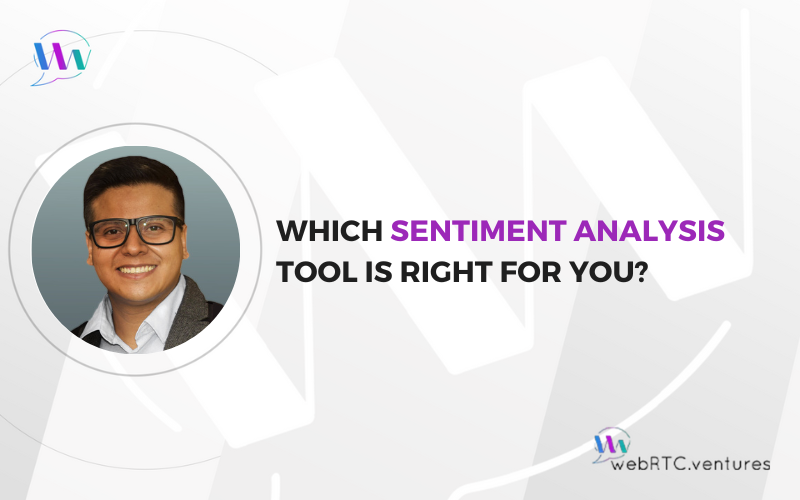Sentiment analysis tools use natural language processing and machine learning techniques to identify, extract, and quantify subjective information from textual data. The ability to reveal feelings and emotions hidden behind a text or interaction has proven extremely useful in brand analysis, PR strategy, market research, business and financial intelligence, social media monitoring, and many more use cases.
Sentiment analysis tools can be integrated into various forms of communication and are especially valuable for WebRTC live video and audio applications. In contact centers, sentiment analysis can provide guidance to live agents, bots, and enterprise centers using AI agent assist. In any of these scenarios, sentiment analysis provides real time feedback to improve the customer experience.
In this post, we will take a look at three sentiment analysis tools: Amazon Rekognition, Azure Cognitive Services, and Symbl.ai. We’ll also show an example of Symbl.ai’s sentiment analysis in action in a sample video conferencing application based on the Amazon Chime SDK.
Amazon Rekognition
Amazon Rekognition is a cloud-based image and video analysis service provided by Amazon Web Services (AWS). It uses deep learning technology to automatically identify objects, people, text, scenes, and activities in images and videos.
Amazon Rekognition provides a range of computer vision capabilities, including facial analysis, facial recognition, and celebrity recognition. It also provides text in image and video detection, scene detection, and object detection.
Amazon Rekognition advantages:
- Video Analysis: Amazon Rekogition can use video instead of text to do the sentiment analysis, analyzing the face expressions.
- Offline and Online (Real-time) Analysis: Amazon Rekognition can do offline analysis using videos or images stored in an S3 bucket. And for online (real-time) analysis, it supports Amazon Kinesis, a streaming data platform.
- Accuracy: Amazon Rekognition is highly accurate in identifying objects, faces, and text within images and videos.
- Scalability: Amazon Rekognition can scale to analyze millions of images and videos per day, making it suitable for large-scale applications.
- Flexibility: Amazon Rekognition can be integrated with other AWS services, such as Amazon S3 and Amazon Kinesis, and supports multiple programming languages.
Amazon Rekognition disadvantages:
- Complexity: Amazon Rekognition may be complex for non-technical users and even for technical uses since it may require specialized knowledge in Amazon tools or training to use effectively.
Amazon Rekognition is a highly accurate and scalable image and video analysis service that can be used to do online or offline sentiment analysis. However, you will need people with Amazon AWS experience and knowledge to implement this tool,since this one is very robust and the documentation is made for technical users. So if you don’t have people with experience or the time to learn, this tool will not be easy to implement. (WebRTC.ventures is proud to be a System Integration Partner with the Amazon Chime SDK and can leverage the power of Amazon Rekognition for you!)
Azure Cognitive Services
Azure Cognitive Services is a cloud-based suite of artificial intelligence (AI) and machine learning services provided by Microsoft Azure. It offers pre-built APIs and tools for adding intelligent features to applications, such as natural language processing, computer vision, and speech recognition.
Azure Cognitive Services advantages:
- Video Analysis: Some capabilities for text analysis sentiment analysis using Computer Vision are offered. However, for more advanced sentiment analysis tasks, Microsoft also offers a dedicated service called Azure Cognitive Services – Text Analytics. This service is specifically designed for natural language processing (NLP) tasks, such as sentiment analysis, key phrase extraction, language detection, and entity recognition.
- Pre-built APIs and tools: Azure Cognitive Services provide pre-built APIs and tools that make it easy for developers to add AI and machine learning capabilities to their applications. This can save time and resources, as developers don’t need to build and train their own models.
- Scalability: Azure Cognitive Services are designed to be highly scalable, which means they can handle large amounts of data and traffic. This makes them suitable for applications with high user traffic or large amounts of data.
Azure Cognitive Services disadvantages:
- Complexity: Azure Cognitive Services may require specialized knowledge in how to use the APIs or training to use them effectively.
- Limited customization: While Azure Cognitive Services provide pre-built APIs and tools, they may not be suitable for all use cases, and there may be limited customization options available. This can be a limitation for more complex or specialized applications.
- Limited control over models: Because Azure Cognitive Services are pre-built, developers may not have as much control over the models and algorithms used in the service. This can be a concern for applications that require more fine-tuned or specific machine learning models.
Azure Cognitive Services include the ease of use, scalability and integration with other Azure services. However, it provides limited customization and control over models, and a steep learning curve for developers.
Overall, Azure Cognitive Services provides a convenient and accessible way for developers to add AI capabilities to their applications, but there may be some limitations depending on the use case.
Symbl.ai
Symbl.ai‘s sentiment analysis capabilities use natural language processing and machine learning algorithms to analyze text and speech data and identify the sentiment of the communication.
In addition to sentiment analysis, Symbl.ai offers a range of other communication analysis features, such as conversation intelligence, topic extraction, and action item detection. These tools can help businesses to better understand and analyze their communication data and gain valuable insights into customer needs, preferences, and behaviors.
Symbl.ai advantages:
- Ease of Use: Symbl.ai is very easy to understand and use. It has clear documentation and examples so you can integrate it with your application.
- Efficient analysis: Using Symbl.ai’s API for sentiment analysis and other communication analysis features can help businesses analyze large amounts of text and speech data quickly and efficiently.
- Actionable insights: The insights gained from sentiment analysis and other communication analysis can help businesses make more informed decisions about their products, services, and customer interactions.
- Customization: Symbl.ai’s API can be customized to meet the specific needs of individual businesses, providing flexibility in how sentiment analysis and other communication analysis features are used.
Symbl.ai disadvantages:
- Limited context: Sentiment analysis and other communication analysis techniques are limited to the text or speech data that is provided. They may not capture the full context of a conversation, which could lead to inaccurate or incomplete insights.
- Text only analysis: Symbl.ai doesn’t have an option to do video or image analysis, it only supports text analysis.
Overall, Symbl.ai’s sentiment analysis and communication analysis features have the potential to provide valuable insights to businesses and it is easy to integrate to a current application with voice features.
In this regard, it would be faster than the other ones to implement. As an example of that, you can find the following video of an integration with a simple Amazon Chime SDK application:
This integration was made in less than a week!
Conclusion
There are multiple sentiment analysis tools available, each one with their own pros and cons. Choosing one over another depends on your team’s expertise (or availability to bring in an integration expert like WebRTC.ventures), specific needs and time-to-market requirements.
If you need help implementing sentiment analysis tools in your existing application or are planning to build one from scratch, WebRTC.ventures can help you decide what’s the best solution for your business and also implement it for you. Contact us today!














